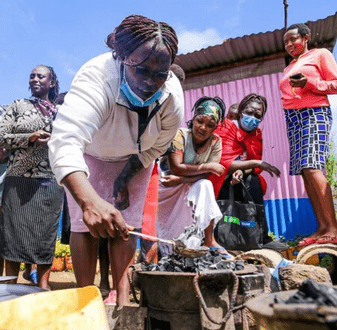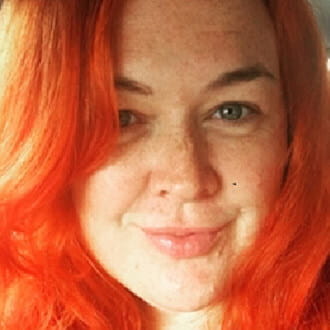From Swahili origins, Nawiri Mama translates to Flourishing Mother, and the focus of this student- led evaluation was twofold.
Firstly, the social development program equips mothers of children with disability living in the Maruri slum in Nairobi with an occupational therapist and a physiotherapist who offer therapy to the children each session and basic physio skills to the mothers or caregivers so they can better help the development of their children at home.
Alongside the health benefits for their children, the social impact program also provides the mothers or caregivers with psycho-social support, a volunteer nutritionist, and vocational training and support to improve their capacity to gain work, or start small businesses, to earn an income. Skills including baking, cooking, detergent making, beadwork, mat making, and basic tailoring skills.
The evaluation collaboration came to fruition through the Torrens University Australia’s Social Enterprise Hub. The hub works across the faculties creating opportunities for students, supported by academics to make connections with industry by working with real clients on actual social impact projects, and Nawiri Mama is one of the hub’s first projects connecting with Public Health students.
“What an amazing opportunity for our students,” said Peter Graves, Manager, Social Enterprise Hub, Torrens University Australia. “An opportunity to develop their skills in program evaluation, to build an evidence base for further expansion of this impactful initiative.”
The Nawiri Mama Program improving social inclusion for mothers with disabled children
The Nawiri Mama Project has been running since 2020 with partner group Bright Futures and Kenyan based NGO Dorcas Creation, with support from the Australian High Commission in Kenya.
In the first two years the Nawiri Mama program has enhanced the life and capacity of over 200 mothers of children, and now our Public Health students have been engaged to discover the true impact of this project.
Jack Snelling, Chief Executive Officer of the Bright Futures Child Aid and Development Fund, has enjoyed collaborating with “proactive” Torrens University students.
“Rigorous evaluations provide assurance to Bright Futures and our donors that our projects are having impact,” said Jack. “It will also be a great resource for donor engagement, with hard evidence that this is an initiative that works.”
Dr Mohammad Kadir, Lecturer in Public Health at Torrens University Australia, is leading this pilot project with Brighter Futures for our students. He was tasked with understanding the project’s scope, and to better understand the participants involved on the ground in Kenya.
A learning experience for both Public Health students and academics
There were a large cohort of capstone students who expressed the interest to work in the applied program to gain an understanding of the project’s scope and produce academic literature reviews on the population they investigated.
“They were really excited to be working on a program trying to change people's lives in a Kenyan slum,” said Mohammad.
“It’s been challenging, but of so much value to our students,” explains Lisa Casanelia, Program Director.
The project was the first social enterprise content weaved into curriculum for the health sciences cohort, connecting to industry in this way. It was a learning experience for both students and academics to ensure they deliver what is required - both for the client, and for our students.
At first, students learned about the context of the program and the targeted population by conducting literature reviews on Kenyan culture, socio-economic conditions of Kenyan slum dwellers, and program evaluation as their individual assessment submission. Students also developed their proposed evaluation frameworks and presented them to stakeholders for feedback.
Next, students collected program related data from program proposals, progress reports, and video recorded interviews of Nawiri Mama mothers involved in the program and conducted stakeholder interviews as part of their data collection process.
“Learning to be flexible and delivering back to the client is obviously important”, said Lisa. “Making sure we get that right so that their participation in the project has also assisted our students to learn and gain valuable experience in an applied context is equally important.”
The first capstone component was completed late 2022.
“This was exploratory and an exciting kind of journey for all of us. We are also coming up with a framework for evaluating any social development program like Nawiri Mama Program with Bright Futures,” said Mohammad.
“If you can’t measure it, you can’t improve it,” said Jack. “It’s been a full-on learning opportunity for all involved but especially of tremendous benefit to Nawiri Mama clients now and in the future.”
The social development program results speak for themselves
According to Mohammad, both students and academics were enthusiastic to explore this program aiming to result in broad changes empowering the mothers of disabled children.
“It’s a great opportunity which has been demanding, and at times challenging, but this knowledge is so valuable, and highly transferable in any program in any area, not only in public health, in education, in business, social development or community development for our students.”
Several students had an emotional response, genuinely connecting with their industry partner, craving the real experience and feedback from working on a program like this.
“It’s definitely something new for them, but they're happy for this applied learning,” said Mohammad.
Jack said that the partnership with Torrens University provided Bright Futures a great study of their partner Dorcas Creations’ Nawiri Mama program.
“We can now demonstrate to donors and potential donors its effectiveness, but more importantly make improvements to increase the project’s impact and effectiveness in transforming the lives of vulnerable women and their children in the slums of Nairobi.”
The Nawiri Mama quarterly report for September to December 2022 stated that the growing number of children being brought for therapy is rising day by day, therefore the next step is to provide more spacious therapy rooms and more equipment.
“Most of the caregivers have gotten over stigma and are now becoming the beam of light in the community by sharing with the community members the importance of therapy,” the report stated.
The biggest learning curve of the program is yet to come
Now, at the halfway point, the next step is to work more closely with stakeholders Dorcas Creation who operate this project in Nairobi slums to collect and interpret more data and evaluate, then produce reports for Bright Futures.
“Our students need to understand why there's little support and why the communities view disability in the way they do,” Lisa explains. “With those sorts of contextualised questions, obviously it’s really important for students to be able to evaluate the program effectively so they need the right lens on when they're viewing the data.”
Lisa said that is when all that hard work will happen, where academics will work diligently with students to ascertain the right outcomes, along with more client collaboration to ensure the project is meeting expectations and needs.
“That's definitely a great opportunity for our students to learn from the practical program happening in the field,” said Mohammad.
There are three groups of students coming up with three proposed evaluation frameworks for the comprehensive evaluation, designing, then implementing, and the outcome evaluation of the program.
Finally, the success of the program is its efficacy and revealing how the program is really achieving the aim of empowering women on the children with disability.
“As you can imagine, we're talking about a very sort of grass roots type of program in a slum area so accessing information can be really challenging and I guess the challenge for students is that it's not going to be nicely ordered in a spreadsheet, like you would expect normal data to be collated,” said Lisa.
“They're going to have to be able to be flexible and improvise, and view outside of frameworks to be able to collect the valuable information about the organic nature of the program to gauge how effective the program was and how it has transformed these mother’s lives.”
“That's the bottom line is really being able to showcase that,” adds Lisa.
The Social Enterprise Hub has bright plans for 2023
The Social Enterprise Hub will continue to support Bright Futures with this and other initiatives.
“The outcome is just the beginning,” said Peter. “It’s exciting.”
The Social Enterprise Hub will further collaborate with the health faculty in the development of an evaluation framework that can be offered to other purpose driven enterprises to assist in creating an evidence base to substantiate their social impact.
Early this year, Business students at Torrens University Australia will build on the outcomes of this evaluation to build marketing collateral to help share the new knowledge and learning from Bright Futures.





